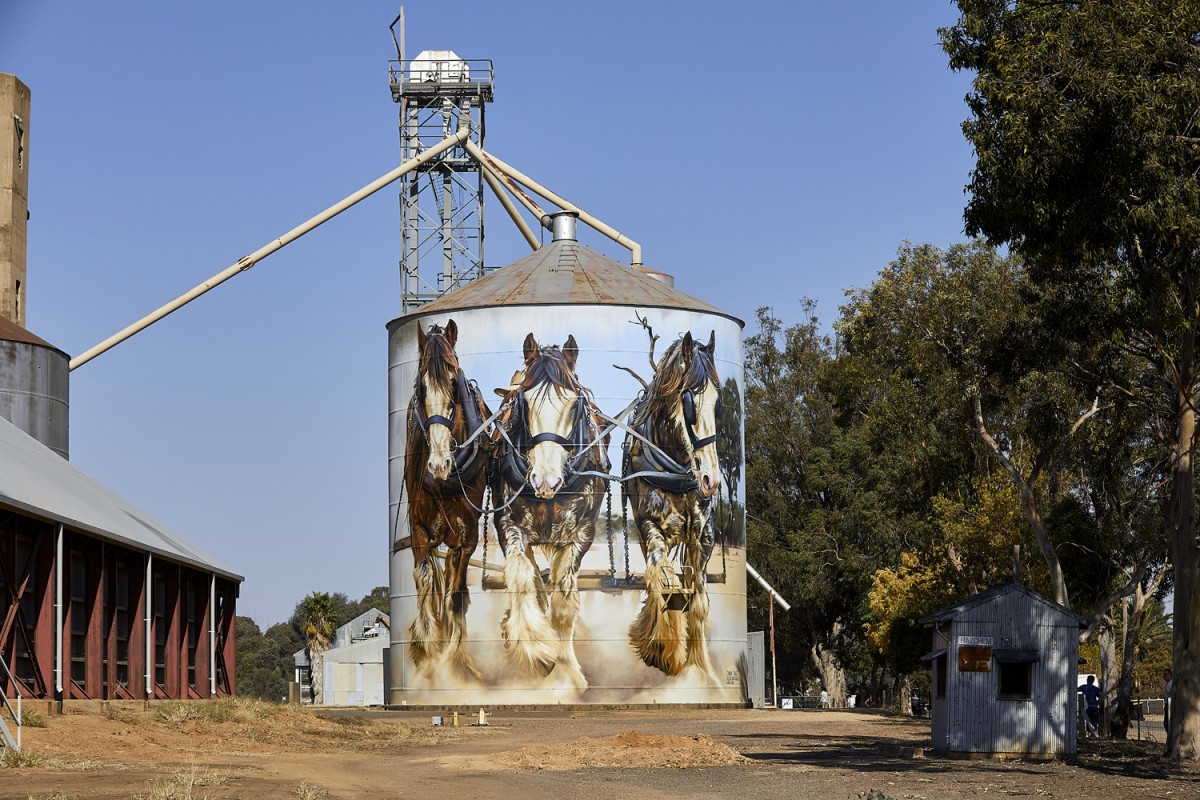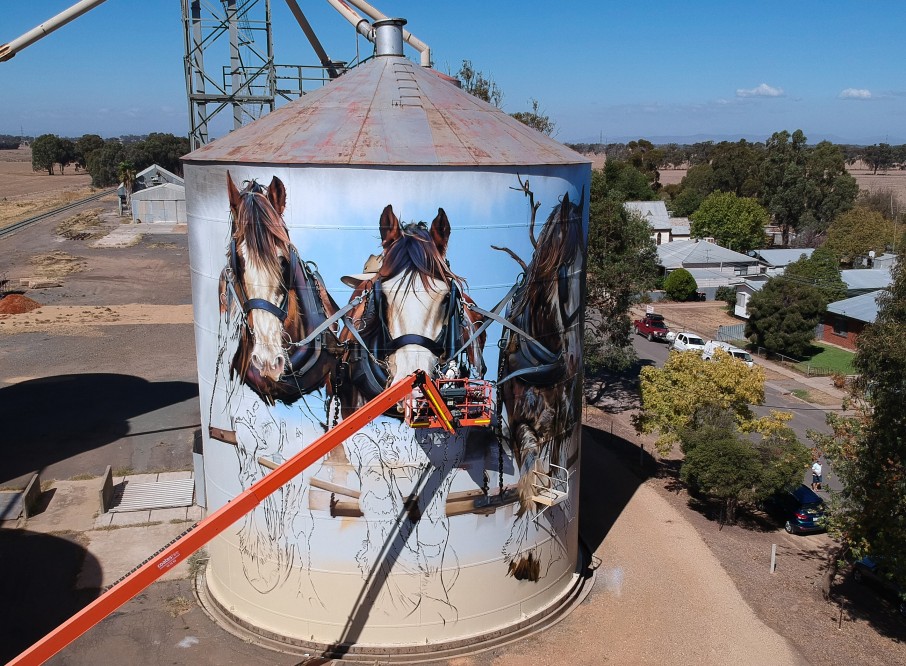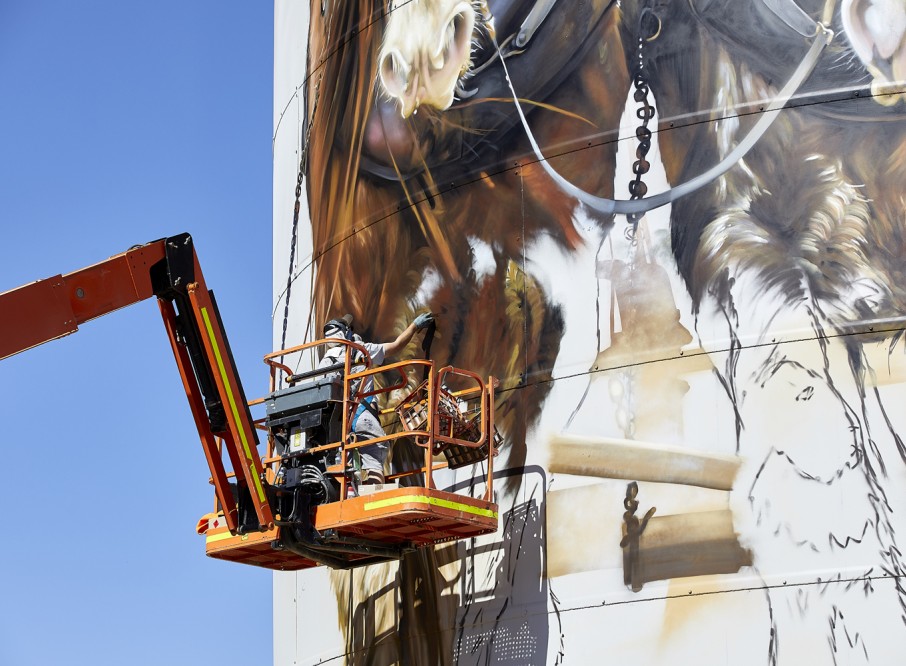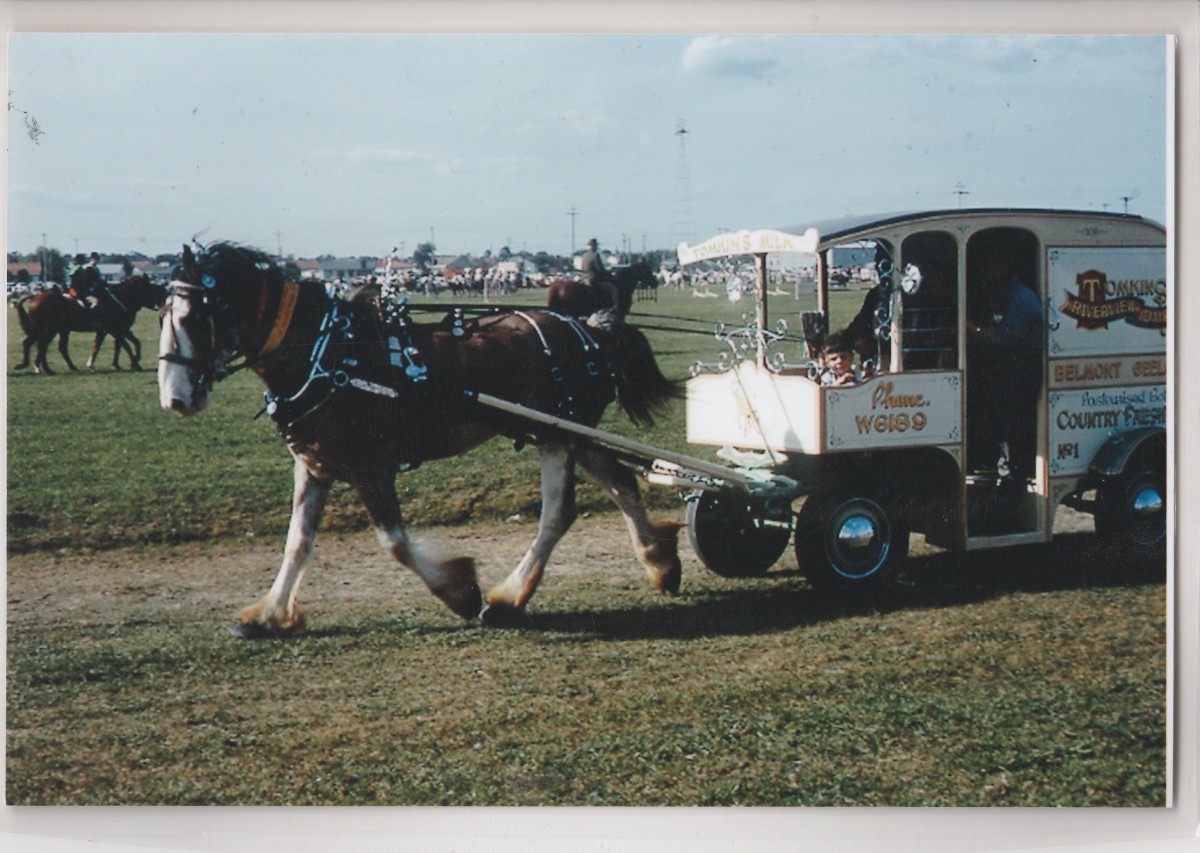Victorian Clydesdale Horse Society
Society News

GENTLE GIANTS NOW GRACE A TOWN'S SILOS AND PAY TRIBUTE TO OLDEST CLYDESDALE STUD
Story by Matt Trewin, Silo artist Jimmy D'Vate, Original Photo Bob Pritcher
Goorambat is a small rural town in North East Victoria, approximately 220km from Melbourne. Its history is agriculture, mainly mixed farms of grains and livestock, and the society and economy of Goorambat is still mostly dependent on agriculture. The town hit the headlines this year after an impressive new mural on its grain silos was commissioned by the local community. Goorambat, like a number of other towns in the area, have grain silos in the centre of town. Goorambat is also close to the Trewin/Martin farm and the home of the Lavereen Clydesdale Stud which will turn 100 next year. Horses bred at the stud were chosen for the art work on the silo. My Grandfather, Tom Trewin, was born just outside of Goorambat, on a property his grandparents selected in the 1870s. Tom had a twin brother, Perce who took over the family dairy farm, with Tom deciding to go sharecropping with a team of horses at the age of 14. He would leave Goorambat on Monday morning with his horses and would work away for the entire week on the properties he farmed.
In 1940, Tom married Eliza May Martin, who was the eldest of three daughters of James Talbot Martin. James Martin was a keen horseman and had established the Lavereen Clydesdale Stud in 1920. However, the origins of the stud go back considerably further, with James’ grandfather, William Richards, who bred and showed draught horses in the colony in the 1880s. His trophies are still at Lavereen, including Star, the Champion Clydesdale Mare of the 1881 Royal Melbourne Show, and Druid, the Champion Clydesdale Stallion at the 1883 Melbourne Show.
Tom and James joined forces in breeding and showing horses and was one of the most successful exhibitors at the Melbourne Show in the late 1940s and early 1950s winning many championships. The horses were not just for showing, but actively worked through the 1950s. The day started at 4am when the dozen or so horses in work were fed, and before they considered having their own breakfast. When mechanisation arrived, the horses were retained for the love of the breed and the stud continued.
When Tom entered Parliament as the Member for Benalla, Graeme took over much of the farming of the property and the day to day duties of the horse stud, which he continues to do til this day.
The story of the actual picture of the horses that were painted on the silos is one of great coincidence. A committee member had found an image of three working Clydesdales and decided it was exactly the image that was wanted. The committee advised that while the image was a perfect one, a picture of local horses was required. Upon checking the providence of the horses in the image, the committee member was astounded to find the horses in the photograph were in fact bred only kilometres away.
The horses featured on the silo are Lavereen Banjo, Lavereen Clement and Coolibah Ridge Sam. Banjo and Clem are from the old breeding stock at Lavereen, dating back to the horses of the 1930s. They were sired by Valmont Scotsman as one of my attempts to breed a black filly. Like so many breeding misadventures, the result was unpredictable with a blue roan colt and a bay colt that had to be reared by bucket by Graeme and Bev. First Banjo, and then Clem, were purchased by David and Nicola Martin and their family from Toowoomba in Queensland and, under the skilful tuition of Dave, they soon set about working and showing the pair. They racked up many Championships in the show ring and in the field and were the ones to beat at Gatton Field Days and the Queensland Ploughing Championships. The horse in the centre is Coolibah Ridge Samuel, bred by David and Nicola, and a successful horse on the Queensland working draught scene. As the mural unfolded, David and Nicola and Bev, Graeme and I watched from the outdoor table at the Goorambat Railway Hotel.
The silo art was painted by respected silo artist Jimmy D'Vate, who is well known for his depictions of endangered species. He had never even sketched a horse in his life, let alone paint three nearly twenty metres high. Dave provided instructions from below where Jimmy had incorrectly painted the harness.
Goorambat turned on an unveiling of the silos in June this year with a street parade which featured a history of agricultural machinery. Horses from the Marriott Family from nearby Tatong and Ian Feldtman from Dookie we also part of the parade.
The silos have been a remarkable success for Goorambat and a constant flow of traffic now turn off the main road into the town to look at the art work. Goorambat was not a tourist destination but now it attracts tens of thousands of people every year. It is fitting that the Clydesdale horse, which helped build the Goorambat community in the 1870s is once again given the town new life.
Image Gallery
State Research Farm
Clydesdale Horses at State Research Farm Werribee In The 1900's
The Milky
A Step Back In Time To Clydesdale Horse Drawn Milk Deliveries.





